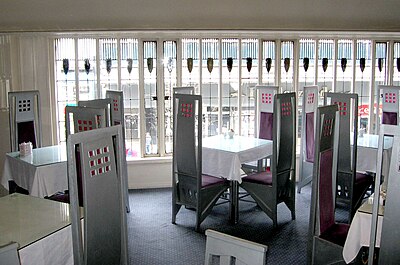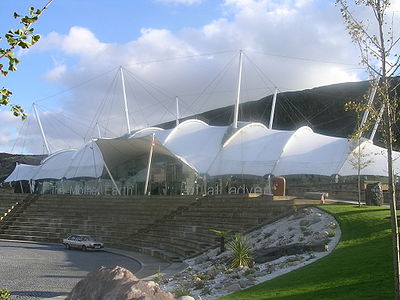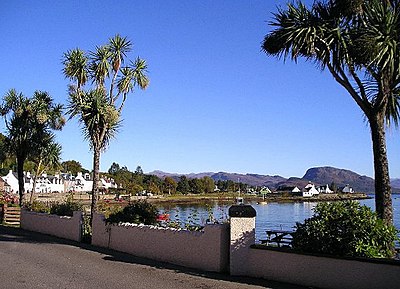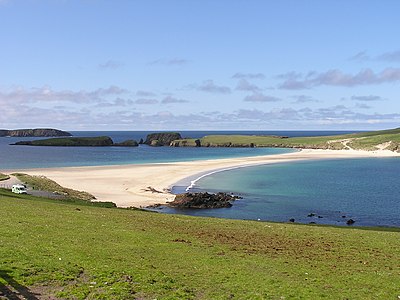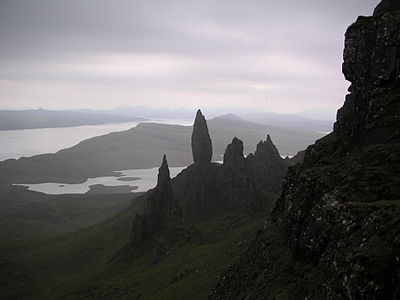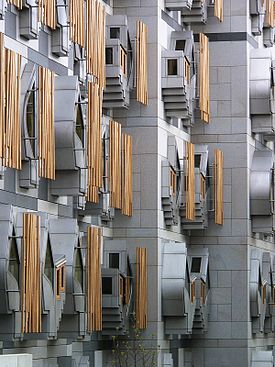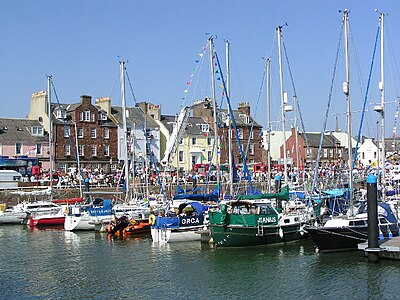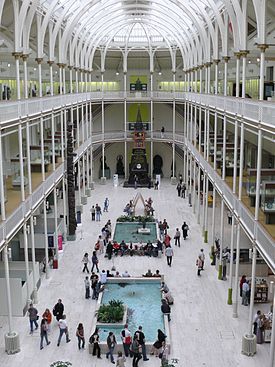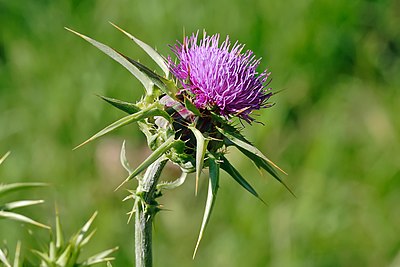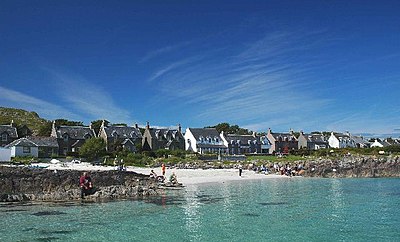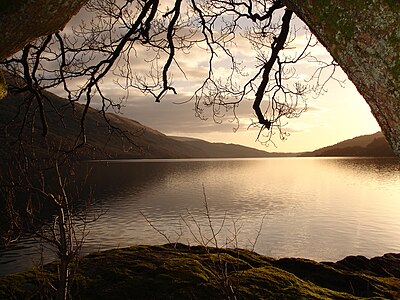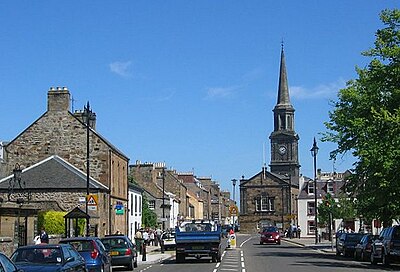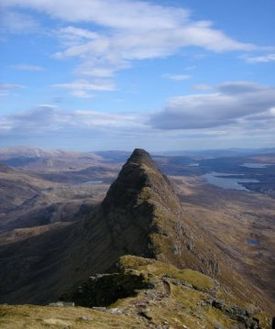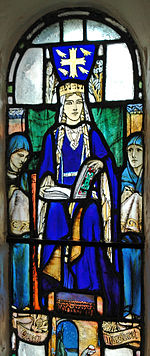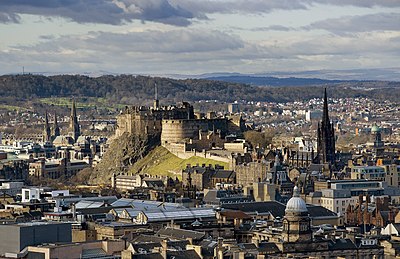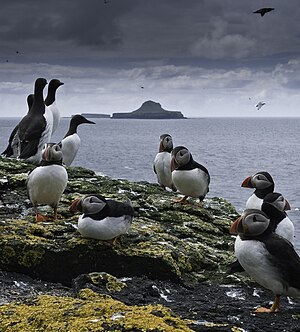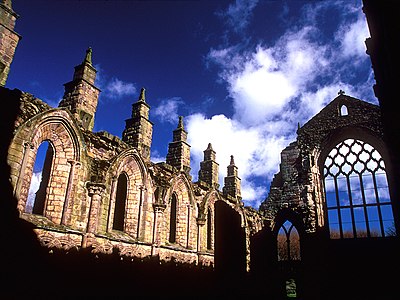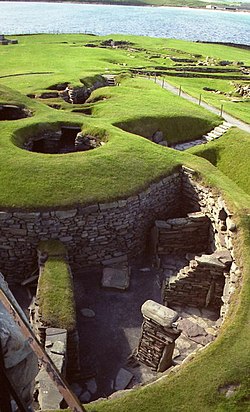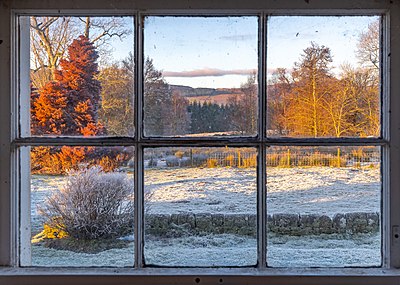Portal:Scotland/Selected pictures
| Main Page | Selected articles 1 | Selected articles 2 | Selected biographies | Selected quotes | Selected pictures | Featured Content | Categories & Topics |
Selected pictures 1
Portal:Scotland/Selected pictures/1
The Falkirk Wheel, named after the nearby town of Falkirk, is a rotating boat lift connecting the Forth and Clyde Canal with the Union Canal. The wheel raises boats by 24 metres (79 ft).
Photo credit: User:SeanMack
Selected pictures 2
Portal:Scotland/Selected pictures/2
Reaper is a restored historic Fifie herring drifter which is registered by the National Historic Ships Committee as part of the Core Collection of historic vessels in the UK, and currently operates as a museum ship.
Photo credit: Scottish Fisheries Museum Boats Club
Selected pictures 3
Portal:Scotland/Selected pictures/3
Wemyss Bay railway station is a railway station on the Inverclyde Line. Located in the village of Wemyss Bay, Inverclyde. The station incorporates the terminal for the Caledonian MacBrayne ferry connecting the mainland to Rothesay on the Isle of Bute.
Photo credit: wilm
Selected pictures 4
Portal:Scotland/Selected pictures/4
The Reverend Robert Walker Skating on Duddingston Loch, better known by its truncated title The Skating Minister, is an oil painting by Sir Henry Raeburn in the National Gallery of Scotland in Edinburgh.
Credit: Sir Henry Raeburn (1790s painting)
Selected pictures 5
Portal:Scotland/Selected pictures/5
Eilean Donan (Scottish Gaelic: Eilean Donnain) is a small tidal island where three sea lochs meet, Loch Duich, Loch Long and Loch Alsh, in the western Highlands.
Photo credit: Diliff
Selected pictures 6
Portal:Scotland/Selected pictures/6
A crannóg (pronounced /krəˈno:g/ or /ˈkrɑno:g/ or /ˈkranag/) is an ancient artificial island or natural island found in Scotland and Ireland, used for a settlement. The name may also refer to a wooden platform erected on shallow loch floors.
Photo credit: Dave Morris
Selected pictures 7
Portal:Scotland/Selected pictures/7
The Isle of Skye, commonly known as Skye, is the largest and most northerly island in the Inner Hebrides. In Scottish Gaelic it is commonly referred to as An t-Eilean Sgiathanach ("The Winged Isle").
Photo credit: masher2
Selected pictures 8
Portal:Scotland/Selected pictures/8
The Willow Tearooms are tearooms at 217 Sauchiehall Street, Glasgow,, designed by internationally renowned architect Charles Rennie Mackintosh, which opened for business in October 1903.
Photo credit: Dave souza
Selected pictures 9
Portal:Scotland/Selected pictures/9
Our Dynamic Earth is a Scottish science centre and prominent conference venue and visitor attraction located in Holyrood, Edinburgh, beside the Scottish Parliament Building.
Photo credit: Globaltraveller
Selected pictures 10
Portal:Scotland/Selected pictures/10
Glen Coe ((Scottish Gaelic: Gleann Comhann) is a glen in the Highlands. It lies in the southern part of the Lochaber committee area of Highland Council, and was formerly part of the county of Argyll.
Photo credit: Gil.cavalcanti
Selected pictures 11
Portal:Scotland/Selected pictures/11
The Lewis chessmen (named after their find-site) belong to some of the few complete medieval chess sets that have survived until today. The chessmen are believed to have been made in Norway, perhaps by craftsmen in Trondheim (where similar pieces have been found), sometime during the 12th century.
Photo credit: Finlay McWalter
Selected pictures 12
Portal:Scotland/Selected pictures/12
Plockton (Scottish Gaelic: Am Ploc/Ploc Loch Aillse) is a picturesque settlement in the Highlands on the shores of Loch Carron. It faces east, away from the prevailing winds, which together with the North Atlantic Drift, gives it a mild climate, allowing palm trees (actually cabbage trees) to grow.
Photo credit: Arthur Bruce
Selected pictures 13
Portal:Scotland/Selected pictures/13
One of the oldest and most important religious centres in western Europe, Iona Abbey is considered the point of origin for the spread of Christianity throughout Scotland. Iona Abbey is located on the Isle of Iona, just off the Isle of Mull on the West Coast.
Photo credit: Dennis Turner
Selected pictures 14
Portal:Scotland/Selected pictures/14
The Torridon Hills surround Torridon village in the Northwest Highlands. The name is usually applied to the mountains to the north of Glen Torridon. They are among the most dramatic and spectacular peaks in the British Isles and made of some of the oldest rocks in the world.
Photo credit: Richard Baker
Selected pictures 15
Portal:Scotland/Selected pictures/15
Eilean Glas Lighthouse, built by engineer Thomas Smith, was one of the original four lights to be commissioned by the Commissioners of the Northern Lights and the first in the Hebrides (the others were Kinnaird Head, Mull of Kintyre and North Ronaldsay).
Photo credit: Richard Baker
Selected pictures 16
Portal:Scotland/Selected pictures/16
The tied island of St Ninian's Isle is joined to the Shetland Mainland by the largest tombolo in the UK.
Photo credit: ThoWi
Selected pictures 17
Portal:Scotland/Selected pictures/17
The Old Man of Storr is a rock pinnacle, the remains of an ancient volcanic plug. It is part of The Storr, a rocky hill overlooking the Sound of Raasay on the Trotternish peninsula of the Isle of Skye.
Photo credit: Wojsy
Selected pictures 18
Portal:Scotland/Selected pictures/18
Crail is a former royal burgh in the East Neuk of Fife. Built around a harbour, it has a particular wealth of vernacular buildings from the 17th to early 19th centuries, many restored by the National Trust for Scotland, and is a favourite subject for artists.
Photo credit: S.moeller
Selected pictures 19
Portal:Scotland/Selected pictures/19
Greyfriars Bobby was a Skye Terrier who became known in 19th-century, Scotland, after reportedly spending fourteen years guarding his owner's grave, until his own death on 14 January 1872. A year after the dog died, the philanthropist Baroness Burdett Coutts, had a statue and fountain erected to commemorate him.
Photo credit: MykReeve
Selected pictures 20
Portal:Scotland/Selected pictures/20
Eilean Ruairidh Mòr is a forested island in Loch Maree, Wester Ross. Its name was formerly anglicised as "Ellan-Rorymore". The islands in Loch Maree are among the least disturbed in Britain and are managed as a National Nature Reserve.
Photo credit: Jerry Sharp
Selected pictures 21
Portal:Scotland/Selected pictures/21
The Scottish Parliament Building (Scottish Gaelic: Pàrlamaid na h-Alba, Scots: Scots Pairlament Biggin) is the home of the Scottish Parliament at Holyrood, within the UNESCO World Heritage Site in central Edinburgh. It was designed by Enric Miralles, the Catalan architect,.and has won a number of awards, including an award at the VIII Biennial of Spanish Architecture, the RIAS Andrew Doolan Award for Architecture, and the 2005 Stirling Prize, the UK's most prestigious architecture award.
Photo credit: Photo Credit: Wangi
Selected pictures 22
Portal:Scotland/Selected pictures/22
Oban (Scottish Gaelic: An t-Òban) (meaning "The Little Bay") is a resort town within the council area of Argyll and Bute. Oban Bay is a near perfect horseshoe bay, protected by the island of Kerrera, and beyond Kerrera is Mull. To the north is the long low island of Lismore, and the mountains of Morvern and Ardgour.
Photo credit: Josi
Selected pictures 23
Portal:Scotland/Selected pictures/23
Soutra Aisle, just within the Scottish Borders, not far from Fala, is the remains of the House of the Holy Trinity, a church that was part of a complex comprising a hospital and a friary. The hospital was founded in 1164 by Malcolm "the Maiden" and is believed to have been the largest hospital in mediæval Scotland.
Photo credit: Wangi
Selected pictures 24
Portal:Scotland/Selected pictures/24
Loch Tummel (Scottish Gaelic: Loch Teimhil) is a long, narrow loch, 7 kilometres north west of Pitlochry in Perth and Kinross. A well known view over the loch and the surrounding countryside (with Schiehallion in the background) is the 'Queen's View' from the north shore, which Queen Victoria made famous in 1866.
Photo credit: Paul Hermans
Selected pictures 25
Portal:Scotland/Selected pictures/25
The Scott Monument is a Victorian Gothic monument to Scottish author Sir Walter Scott (not to be confused with the National Monument). It stands in Princes Street Gardens in Edinburgh.
Photo credit: Schatir
Selected pictures 26
Portal:Scotland/Selected pictures/26
Arbroath or Aberbrothock (Scottish Gaelic: Obair Bhrothaig) is a former royal burgh on the North Sea coast, around 16 miles (25.7 km) ENE of Dundee and 45 miles (72.4 km) SSW of Aberdeen. It is the largest town in the council area of Angus. and has a population of 22,785.
Photo credit: Karen Vernon
Selected pictures 27
Portal:Scotland/Selected pictures/27
St Mary's Cathedral is a Roman Catholic church located in Edinburgh, Scotland. It is the seat of the Archbishop of Saint Andrews and Edinburgh and the mother church of Scots Catholicism.
Photo credit: Michael D Beckwith
Selected pictures 28
Portal:Scotland/Selected pictures/28
The National Museum of Scotland is one of Scotland's national museums, on Chambers Street, in Edinburgh. The original Royal Museum began in the 19th century and was added to in the 1990s when a new building known as The Museum of Scotland was added, both merging in 2007 into The National Museum of Scotland.
Photo credit: Shimgray
Selected pictures 29
Portal:Scotland/Selected pictures/29
The Wallace Monument is a sandstone tower, built in the Victorian Gothic style. It stands on the summit of Abbey Craig, a volcanic crag above Cambuskenneth Abbey, from which Wallace was said to have watched the gathering of the army of English king Edward I, just before the Battle of Stirling Bridge.
Photo credit: Ray Mann
Selected pictures 30
Portal:Scotland/Selected pictures/30
Fair Isle (from Old Norse Frjóey) (Scottish Gaelic: Eileann nan Geansaidh) is an island off Scotland, lying around halfway between Shetland and the Orkney Islands. The most remote inhabited island in the United Kingdom, it is famous for its bird observatory and a traditional style of knitting.
Photo credit: Dave Wheeler
Selected pictures 31
Portal:Scotland/Selected pictures/31
Calton Hill is a hill in central Edinburgh, just to the east of the New Town. The hill is home to several iconic monuments and buildings: the National Monument, Nelson's Monument, the Dugald Stewart Monument, the Royal High School, the Robert Burns Monument, the Political Martyrs' Monument and the City Observatory.
Photo credit: Andrewyuill
Selected pictures 32
Portal:Scotland/Selected pictures/32
Thistle is the common name of a group of flowering plants characterised by leaves with sharp prickles on the margins, mostly in the family Asteraceae. In the language of flowers, the thistle (like the burr) is an ancient Celtic symbol of nobility of character as well as of birth, for the wounding or provocation of a thistle yields punishment.
Photo credit: Fir0002
Selected pictures 33
Portal:Scotland/Selected pictures/33
The Glasgow Necropolis is a Victorian cemetery in Glasgow. It sits on a hill above, and to the east of, St. Mungo's Cathedral. It was conceived as a Père Lachaise for Glasgow, and subsequently established by the Merchants' House of Glasgow in 1831. Fifty thousand individuals have been buried in approximately 3500 tombs.
Photo credit: Finlay McWalter
Selected pictures 34
Portal:Scotland/Selected pictures/34
Loch Etive (Scottish Gaelic: Loch Eite) is a 30 km sea loch in Argyll and Bute. The name Etive is believed to mean "little ugly one" from the Gaelic Goddess associated with the loch. A road along Glen Etive makes the head of the loch accessible from Glen Coe.
Photo credit: Jamie Campbell
Selected pictures 35
Portal:Scotland/Selected pictures/35
Dunfermline Abbey is a large Benedictine abbey in Dunfermline, Fife. It was administered by the Abbot of Dunfermline. The abbey was founded in 1128 by King David I, but the monastic establishment was based on an earlier foundation dating back to the reign of King Máel Coluim mac Donnchada (i.e. "Malcolm III" or "Malcolm Canmore", r. 1058-93).
Photo credit: Andy Stephenson
Selected pictures 36
Portal:Scotland/Selected pictures/36
Iona (Scottish Gaelic: Ì Chaluim Chille) is a small island in the Inner Hebrides off the western coast of Scotland. It was a centre of Celtic Christianity for four centuries and is today renowned for its tranquility and natural beauty. It is a popular tourist destination.
Photo credit: Graham Proud
Selected pictures 37
Portal:Scotland/Selected pictures/37
Loch Lomond (Scottish Gaelic: Loch Laomainn) is a freshwater Scottish loch, lying on the Highland Boundary Fault. It is the largest loch/lake in Great Britain, by surface area, and contains many islands, including Inchmurrin, the largest fresh water island in the British Isles.
Photo credit: Abubakr.h
Selected pictures 38
Portal:Scotland/Selected pictures/38
New Lanark is a village on the River Clyde, approximately 1.4 miles (2.2 kilometres) from Lanark, in South Lanarkshire. It was founded in 1786 by David Dale, who built cotton mills and housing for the mill workers. Under the ownership of a partnership that included Dale's son-in-law, Robert Owen, a Welsh philanthropist and social reformer, New Lanark became a successful business and an epitome of utopian socialism.
Photo credit: Gordon Brown
Selected pictures 39
Portal:Scotland/Selected pictures/39
Loch Leven (Scottish Gaelic: Loch Lìobhann) is a sea loch on the west coast of Scotland. Loch Leven extends 8¾ miles (14 km), varying in width between 220 yards (200 m) and just over a mile (1.8 km). It opens onto Camus a'Chois at North Ballachulish, part of Loch Linnhe at its western end.
Photo credit: Cactus.man
Selected pictures 40
Portal:Scotland/Selected pictures/40
The geography of Scotland is highly varied, from rural lowlands to barren uplands, and from large cities to uninhabited islands. Aside from the mainland, Scotland is surrounded by 790 islands encompassing the major archipelagoes of the Shetland Islands, Orkney Islands and the Outer Hebrides.
Photo credit: NASA
Selected pictures 41
Portal:Scotland/Selected pictures/41
The Royal Burgh of Haddington is a town in East Lothian. It is the main administrative, cultural and geographical centre for East Lothian, which was known officially as Haddingtonshire before 1921. It lies approximately 20 miles (32 km) east of Edinburgh.
Photo credit: Richard Webb
Selected pictures 42
Portal:Scotland/Selected pictures/42
Dunnottar Castle (Scottish Gaelic: Dùn Fhoithear, meaning "fort on the shelving slope") is a ruined medieval fortress located upon a rocky headland on the north-east coast of Scotland, about two miles (3 km) south of Stonehaven. The surviving buildings are largely of the 15th–16th centuries, but the site is believed to have been an early fortress of the Dark Ages.
Photo credit: Andrewmckie
Selected pictures 43
Portal:Scotland/Selected pictures/43
Suilven (Scottish Gaelic: Sula Bheinn) is one of the most distinctive mountains in Scotland. Lying in a remote area in the west of Sutherland, it rises almost vertically from a wilderness landscape of moorland, bogs and lochans known as Inverpolly National Nature Reserve. The mountain forms a steep-sided ridge some 2 km in length. The highest point, known as Caisteal Liath (meaning "the Grey Castle"), lies at the northwest end of this ridge.
Photo credit: Grinner
Selected pictures 44
Portal:Scotland/Selected pictures/44
Aberdour Castle is located in the village of Easter Aberdour, Fife. Parts of the castle date from around 1200, making Aberdour one of the two oldest datable standing castles in Scotland, along with Castle Sween in Argyll, which was built at around the same time.
Photo credit: Andy Hawkins
Selected pictures 45
Portal:Scotland/Selected pictures/45
Loch Fyne (Scottish Gaelic: Loch Fìne, meaning "Loch of the Vine or Wine", is a sea loch on the west coast of Argyll and Bute. Although there is no evidence for grapes growing there, it was more metaphorical, such as meaning that the River, Abhainn Fìne, was a well-respected river.
Photo credit: Michael Parry
Selected pictures 46
Portal:Scotland/Selected pictures/46
Scott's View refers to a viewpoint in the Scottish Borders, overlooking the valley of the River Tweed, which is reputed to be one of the favourite views of Sir Walter Scott. The viewpoint can be located directly from a minor road leading south from Earlston just off the A68 and by travelling north from the village of St. Boswells up the slope of Bemersyde Hill. The view is around 3 miles east of Melrose.
Photo credit: Semi-detached
Selected pictures 47
Portal:Scotland/Selected pictures/47
Loch Shiel (Scottish Gaelic: Loch Seile) is a 19.3 km2 freshwater loch, 120 m deep, situated 20 km west of Fort William in Lochaber, Highland. It is enclosed by mountains in the north east and surrounded by bog and rough pasture in the south west, from which end the 4 km River Shiel drains to the sea in Loch Moidart near Castle Tioram.
Photo credit: Gil Cavanti
Selected pictures 48
Portal:Scotland/Selected pictures/48
Durness (Scottish Gaelic: Diùirnis) is a huge but remote parish in the northwestern Highlands, encompassing all the land between the Moine to the East (separating it from Tongue parish) and the Gualin to the West (separating it from Eddrachilis).
Photo credit: Neil Booth
Selected pictures 49
Portal:Scotland/Selected pictures/49
The Crinan canal is a canal in the west of Scotland, taking its name from the village of Crinan at its westerly end. It provides a navigable route between the Clyde and the Inner Hebrides, without the need for a long diversion around the Kintyre peninsula, and in particular the exposed Mull of Kintyre.
Photo credit: Velella
Selected pictures 50
Portal:Scotland/Selected pictures/50
St Margaret's Chapel, at Edinburgh Castle, is the oldest surviving building in Edinburgh. An example of Romanesque architecture, it is a Category A listed building. Legend had it that St. Margaret worshipped in this small chapel, but recent research indicates that it was built at the beginning of the 12th century by her fourth son who became King David I in 1124
Photo credit: Kjetilbjornsrud
Selected pictures 51
Portal:Scotland/Selected pictures/51
The River Tweed, or Tweed Water, (Scottish Gaelic: Abhainn Thuaidh) is 97 miles (156 km) long and flows primarily through the Borders region of Great Britain. It rises on Tweedsmuir at Tweed's Well near where the Clyde, draining northwest, and the Annan draining south also rise.
Photo credit: Jean Walley
Selected pictures 52
Portal:Scotland/Selected pictures/52
Castle Stalker (Scottish Gaelic: Caisteal an Stalcaire) is a four-storey tower house or keep picturesquely set on a tidal islet on Loch Laich, an inlet off Loch Linnhe. It is located about 1.5 miles (2.4 km) north east of Port Appin, Argyll.
Photo credit: Mike Searle
Selected pictures 53
Portal:Scotland/Selected pictures/53
The Scottish National Gallery, in Edinburgh, is the national art gallery of Scotland. An elaborate neoclassical edifice, it stands on The Mound, between the two sections of Edinburgh's Princes Street Gardens. The building, which was designed by William Henry Playfair, first opened to the public in 1859.
Photo credit: Klaus with K
Selected pictures 54
Portal:Scotland/Selected pictures/54
Glenfinnan Viaduct is a railway viaduct on the West Highland Line in Glenfinnan, Lochaber, Highland. It was built between 1897 and 1901. Located at the top of Loch Shiel in the West Highlands, the viaduct overlooks the Glenfinnan Monument and the waters of Loch Shiel.
Photo credit: Nicolas17
Selected pictures 55
Portal:Scotland/Selected pictures/55
The Forth Bridge is a cantilever railway bridge over the Firth of Forth. It was opened on 4 March 1890, and spans a total length of 2,528.7 metres (8,296 ft). It is often called the Forth Rail Bridge or Forth Railway Bridge to distinguish it from the Forth Road Bridge.
Photo credit: George Gastin
Selected pictures 56
Portal:Scotland/Selected pictures/56
Hopetoun House is the traditional residence of the Earl of Hopetoun (later the Marquess of Linlithgow). It was built 1699-1701, designed by William Bruce. It was then hugely extended from 1721 by William Adam until his death in 1748 being one of his most notable projects. The parklands in which it lies were laid out in 1725, also by William Adam.
Photo credit: George Gastin
Selected pictures 57
Portal:Scotland/Selected pictures/57
Blair Castle stands in its grounds near the village of Blair Atholl in Perthshire. The Castle is said to have been started in 1269 by John I Comyn, Lord of Badenoch, a northern neighbour of the Earl of Atholl, who started building on the Earl's land while he was away on crusade.
Photo credit: Hasso Weber
Selected pictures 58
Portal:Scotland/Selected pictures/58
Calton Hill (archaically spelt Caltoun Hill,) is a hill in central Edinburgh, just to the east of the New Town. It is the headquarters of the Scottish Government, which is based at St Andrew's House, on the steep southern slope of the hill; with the Scottish Parliament Building lying near the foot of the hill.
Photo credit: Saffron Blaze
Selected pictures 59
Portal:Scotland/Selected pictures/59
Bealach na Bà is a historic pass through the mountains of the Applecross peninsula, in Wester Ross in the Scottish Highlands—and the name of a famous twisting, single-track mountain road through the pass and mountains. The road is one of few in the Scottish Highlands that is engineered similarly to roads through the great mountain passes in the Alps, with very tight hairpin bends that switch back and forth up the hillside.
Photo credit: Stefan Krause
Selected pictures 60
Portal:Scotland/Selected pictures/60
The Bruichladdich distillery is a distillery on the Rhinns of the isle of Islay in Scotland. The distillery produces mainly single malt Scotch whisky, but has also offered artisanal gin.
Photo credit: Bdcl1881
Selected pictures 61
Portal:Scotland/Selected pictures/61
Loch Linnhe is a sea loch on the west coast of Scotland. The part upstream of Corran is known in Gaelic as An Linne Dhubh (the black pool, originally known as Loch Abar), and downstream as An Linne Sheileach (the salty pool). The name Linnhe is derived from the Gaelic word linne, meaning "pool".
Photo credit: Moralist
Selected pictures 62
Portal:Scotland/Selected pictures/62
Edinburgh Castle is a fortress which dominates the skyline of the city of Edinburgh, from its position atop the volcanic Castle Rock. Human habitation of the site is dated back as far as the 9th century BC, although the nature of early settlement is unclear. There has been a royal castle here since at least the reign of King David in the 12th century, and the site continued to be a royal residence until the Union of the Crowns in 1603.
Photo credit: Saffron_Blaze
Selected pictures 63
Portal:Scotland/Selected pictures/63
Cramond (Scottish Gaelic: Cathair Amain) is a seaside village now part of suburban Edinburgh, located in the north-west corner of the city at the mouth of the River Almond where it enters the Firth of Forth. The Cramond area has a long history, with evidence of Mesolithic, Bronze Age and Roman activity.
Photo credit: Steven Harrison
Selected pictures 64
Portal:Scotland/Selected pictures/64
Limestone carving of Scotland's heraldic lion above the entrance to the Queen's Gallery, Edinburgh
Photo credit: Stefan2901
Selected pictures 65
Portal:Scotland/Selected pictures/65
Loch Torridon (Scottish Gaelic: Loch Thoirbheartan) is a sea loch on the west coast of the Northwest Highlands. The loch was created by glacial processes and is in total around 15 miles (25 km) long. It has two sections: Upper Loch Torridon to landward, east of Rubha na h-Airde Ghlaise, at which point it joins Loch Sheildaig; and the main western section of Loch Torridon proper.
Photo credit: Stefan Krause
Selected pictures 66
Portal:Scotland/Selected pictures/66
Puffins and guillemots on Lunga in the Treshnish Isles, with Bac Mòr (known as Dutchman's Cap for its distinctive shape) in the background.
Photo credit: Simaron
Selected pictures 67
Portal:Scotland/Selected pictures/67
The Cuillin (Scottish Gaelic: An Cuilthionn (or An Cuiltheann)) are properly and locally known as The Cuillins in the plural, and are a range of rocky mountains located on the Isle of Skye. The true Cuillin is also known as the Black Cuillin to distinguish it from the Red Hills (na Beanntan Dearga) across Glen Sligachan.
Photo credit: Andrewmckie
Selected pictures 68
Portal:Scotland/Selected pictures/68
RRS Discovery was the last traditional wooden three-masted ship to be built in Britain. Designed for Antarctic research, she was launched as a Royal Research Ship (RRS) in 1901. Her first mission was the British National Antarctic Expedition, carrying Robert Falcon Scott and Ernest Shackleton on their first, successful journey to the Antarctic, known as the Discovery Expedition. She is now the centrepiece of a visitor attraction in her home, Dundee.
Photo credit: Mactographer
Selected pictures 69
Portal:Scotland/Selected pictures/69
Skara Brae is a stone-built Neolithic settlement, located on the Bay of Skaill on the west coast of Mainland, the largest island in the Orkney archipelago. It consists of eight clustered houses, and was occupied from roughly 3180 BCE–2500 BCE. Europe's most complete Neolithic village, Skara Brae gained UNESCO World Heritage Site status as one of four sites making up "The Heart of Neolithic Orkney".
Photo credit: craig w macgregor
Selected pictures 70
Portal:Scotland/Selected pictures/70
Holyrood Abbey is a ruined abbey of the Canons regular in Edinburgh. The abbey was founded in 1128 by King David. During the 15th century, the abbey guesthouse was developed into a royal residence, and after the Scottish Reformation the Palace of Holyroodhouse was expanded further. The abbey church was used as a parish church until the 17th century, and has been ruined since the 18th century.
Photo credit: laszlo-photo
Selected pictures 71
Portal:Scotland/Selected pictures/71
Tobermoray (Scottish Gaelic: Tobar Mhoire) is the capital of, and the only burgh on, the Isle of Mull in the Inner Hebrides. It is located in the northeastern part of the island, near the northern entrance of the Sound of Mull. The town was founded as a fishing port in 1788, its layout based on the designs of Dumfriesshire engineer Thomas Telford.
Photo credit: Lukas von Daeniken
Selected pictures 72
Portal:Scotland/Selected pictures/72
Braemar is a village in Aberdeenshire, around 58 miles (93 km) west of Aberdeen in the Highlands. Sitting at an altitude of 339 metres (1,112 ft), Braemar is the third coldest low lying place in the UK, after the villages of Dalwhinnie and Leadhills. It has twice entered the UK Weather Records with the lowest ever UK temperature of -27.2oC, on 11 February 1895, and 10 January 1982.
Photo credit: Paul Chapman
Selected pictures 73
Portal:Scotland/Selected pictures/73
A broch is an Iron Age drystone hollow-walled structure of a type found only in Scotland. Brochs belong to the classification "complex atlantic roundhouse" devised by Scottish archaeologists in the 1980s. Their origin is a matter of some controversy.
Photo credit: Otter
Selected pictures 74
Portal:Scotland/Selected pictures/74
Jarlshof is the best known prehistoric archaeological site in Shetland. It lies near the southern tip of the Shetland Mainland and has been described as "one of the most remarkable archaeological sites ever excavated in the British Isles".
Photo credit: Nigel Duncan
Selected pictures 75
Portal:Scotland/Selected pictures/75
Barra Airport (Scottish Gaelic: Port-adhair Bharraigh) (IATA: BRR, ICAO: EGPR) (also known as Barra Eoligarry Airport) is a short-runway airport (or STOLport) situated in the wide shallow bay of Traigh Mhòr at the north tip of the island of Barra in the Outer Hebrides, Scotland. The airport is unique, being the only one in the world where scheduled flights use a beach as the runway. The airport is operated by Highlands and Islands Airports Limited, which owns most of the regional airports in mainland Scotland and the outlying islands.
Photo credit: Steve Holdsworth
Selected pictures 76
Portal:Scotland/Selected pictures/76
A common seal (Phoca vitulina) seen basking on rocks off Lismore Argyll.
Photo credit: Sharp Photography
Selected pictures 77
Portal:Scotland/Selected pictures/77
Cells of Life, a landform by Charles Jencks at Jupiter Artland.
Photo credit: Allan Pollok-Morris
Selected pictures 78
Portal:Scotland/Selected pictures/78
Sunset in Loch Lomond and The Trossachs National Park. The high peak on left of the image is Ben Lomond.
Photo credit: Michal Klajban
Selected pictures 79
Portal:Scotland/Selected pictures/79
View of the Trossachs countryside through a farm window on a frosty evening.
Photo credit: Michal Klajban
Selected pictures 80
Portal:Scotland/Selected pictures/80
A bank of trees shrouded in fog on the northern shores of Loch Tay.
Photo credit: Michal Klajban
Selected pictures 81
Portal:Scotland/Selected pictures/81
A peat bog below the top of Doune Hill in the Luss hills.
Photo credit: Michal Klajban
Selected pictures 82
Portal:Scotland/Selected pictures/82
Sunrise over Ben Vorlich and Loch Tay.
Photo credit: Michal Klajban
Selected pictures 83
Portal:Scotland/Selected pictures/83
Traigh Iar (Horgabost beach), Harris.
Photo credit: Gordon Hatton









